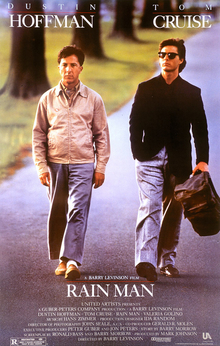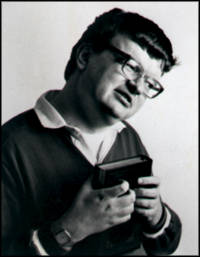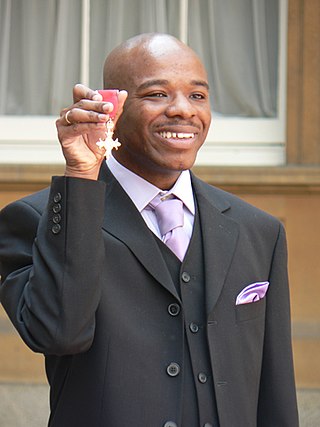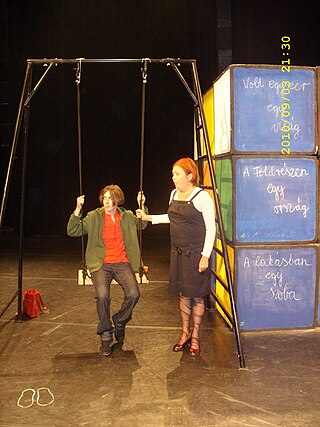
Rain Man is a 1988 American road comedy-drama film directed by Barry Levinson and written by Barry Morrow and Ronald Bass. It tells the story of abrasive, selfish, young wheeler-dealer Charlie Babbitt, who discovers that his estranged father has died and bequeathed virtually all of his multimillion-dollar estate to his other son, Raymond, an autistic savant of whose existence Charlie was unaware. Charlie is left with only his father's beloved vintage car and rosebushes. Valeria Golino also stars as Charlie's girlfriend, Susanna. Morrow created the character of Raymond after meeting Kim Peek, a real-life savant; his characterization was based on both Peek and Bill Sackter, a good friend of Morrow who was the subject of Bill, an earlier film that Morrow wrote.
Richard Wawro was a Scottish artist notable for his landscapes in wax oil crayon. He was an autistic savant.

Savant syndrome is a phenomenon where someone demonstrates exceptional aptitude in one domain, such as art or mathematics, despite significant social or intellectual impairment.

Donna Leanne Williams, also known by her married name Donna Leanne Samuel and as Polly Samuel, was an Australian writer, artist, singer-songwriter, screenwriter, and sculptor.

Stephen Wiltshire is a British architectural artist and autistic savant. He is known for his ability to draw a landscape from memory after seeing it just once. His work has gained worldwide popularity.

Alexis Rockman is an American contemporary artist known for his paintings that provide depictions of future landscapes as they might exist with impacts of climate change and evolution influenced by genetic engineering. He has exhibited his work in the United States since 1985, including a 2004 exhibition at the Brooklyn Museum, and internationally since 1989. He lives with his wife, Dorothy Spears in Warren, CT and NYC.

The autism rights movement, also known as the autistic acceptance movement, is a social movement allied with disability rights that emphasizes a neurodiversity paradigm, viewing autism as a disability with variations in the human brain rather than as a disease to be cured. The movement advocates for several goals, including greater acceptance of autistic traits and behaviors; reforms of services - i.e. services that focus on improving quality of life and well-being instead of suppression and masking of autistic traits that are adaptive or not harmful or imitations of social behaviors of allistic (non-autistic) peers ; the creation of social networks and events that allow autistic people to socialize on their own terms; and the recognition of the autistic community as a minority group.

Edward Alexander Wadsworth was a British artist initially associated with the Vorticism movement. In the First World War he was part of a team involved in the transfer of dazzle camouflage designs to ships for the Royal Navy. After the war his maritime landscapes and still-life compositions using tempera were infused with a surrealistic mood - although he never exhibited with the British surrealists. In the early thirties and in the early forties his work was mainly abstract. He made a significant contribution to the development of modern art in Britain in the inter-war years.
George Widener is a self-taught artist who employs his mathematical/calculating capability to create art ranging from complex calendars and numerical palindromes to Rembrandt-like antiquarian landscapes to Asian scrolls. He was born in Cincinnati, Ohio.

Henriett Seth F., also known by the Hungarian pseudonym Seth F. Henriett, is a Hungarian autistic savant poet, writer, musician and artist.
Gerald Newport (1948–2023), better known as Jerry Newport, and Mary Newport, née Mary Meinel, also known as Mary Meinel-Newport, were authors, advocates, and public speakers who had been diagnosed with Asperger syndrome and whose lives became the basis for the 2005 film Mozart and the Whale. Their written works include self-help books related to autism and Asperger's, as well as their 2007 memoir Mozart and the Whale: An Asperger's Love Story.

Autistic art is artwork created by autistic artists that captures or conveys a variety of autistic experiences. According to a 2021 article in Cognitive Processing, autistic artists with improved linguistic and communication skills often show a greater degree of originality and attention to detail than their neurotypical counterparts, with a positive correlation between artistic talent and high linguistic functioning. Autistic art is often considered outsider art. Art by autistic artists has long been shown in separate venues from artists without disabilities. The works of some autistic artists have featured in art publications and documentaries and been exhibited in mainstream galleries. Although autistic artists seldom received formal art education in the past, recent inclusivity initiatives have made it easier for autistic artists to get a formal college education. The Aspergers/Autism Network's AANE Artist Collaborative is an example of an art organization for autistic adults.

Societal and cultural aspects of autism or sociology of autism come into play with recognition of autism, approaches to its support services and therapies, and how autism affects the definition of personhood. The autistic community is divided primarily into two camps; the autism rights movement and the Pathology paradigm. The pathology paradigm advocates for supporting research into therapies, treatments, and/or a cure to help minimize or remove autistic traits, seeing treatment as vital to help individuals with autism, while the neurodiversity movement believes autism should be seen as a different way of being and advocates against a cure and interventions that focus on normalization, seeing it as trying to exterminate autistic people and their individuality. Both are controversial in autism communities and advocacy which has led to significant infighting between these two camps. While the dominant paradigm is the pathology paradigm and is followed largely by autism research and scientific communities, the neurodiversity movement is highly popular among most autistic people, within autism advocacy, autism rights organizations, and related neurodiversity approaches have been rapidly growing and applied in the autism research field in the last few years.
Clara Claiborne Park was an American college English teacher and author who was best known for her writings about her experiences raising her autistic daughter, the artist Jessica Park. Her 1967 book, The Siege was credited as one of the first books to allay the blame that parents, especially mothers, were made to feel at having caused their child's autism through their cold detachment.
Timothy William Sharp is an Australian artist who has been diagnosed as autistic and is most famous for his creation of the colourful super hero Laser Beak Man. In 2010, Sharp's work garnered international attention when Laser Beak Man was turned into an eight episode animated television series screening in Australia on ABC3 TV and it was then sold to Cartoon Network Australia, New Zealand and Asia – a world first for a young man with autism to achieve.
Hypercalculia is "a specific developmental condition in which the ability to perform mathematical calculations is significantly superior to general learning ability and to school attainment in maths." A 2002 neuroimaging study of a child with hypercalculia suggested greater brain volume in the right temporal lobe. Serial SPECT scans revealed hyperperfusion over right parietal areas during performance of arithmetic tasks.
Gray Foy was an American artist who created a visionary body of drawings from 1941 to 1975. His drawings are generally divided into two phases. First, from 1941 to 1948, the artist drew figurative Surrealist landscapes and interiors. Then beginning in the late 1940s, he concentrated on botanical subject matter, both naturalistic and imagined.
Ping Lian Yeak is a Malaysian Australian artist based in Sydney. He is described as having reached a significant artistic achievement. He was diagnosed with autism at a young age.

Gregory Lee Blackstock was an American self-taught artist. Regarded as an autistic savant, Blackstock created drawings featuring orderly categories of types of objects. A feature article on the artist by the Seattle Weekly described him as an "anthropologist of the everyday." An exhibit review by Seattle Times art critic Robert Ayers described his impact by declaring "Gregory Blackstock is one of our city's greatest artists."
Nadia Chomyn was a British autistic artist who was born in Nottingham. Considered severely handicapped both intellectually and motorically, she is best known for her realistic drawings as a child prodigy, depicting mainly horses and roosters. Nadia's mastery of perspective, and her extremely rapid and precise line drawing from the age of three and a half, earned her the title of "autistic savant". She aroused interest in the anglophone media, psychiatry and art therapy publications in the late 1970s and early 1980s, particularly with regard to the question of whether interventions for autistic children could lead to a parallel loss of other skills.









